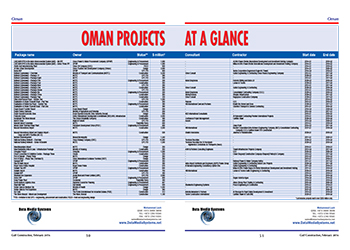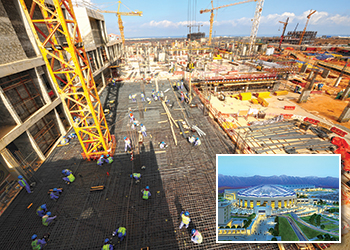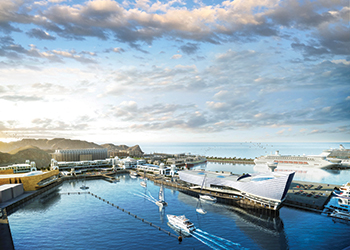
 Oman Conference and Exhibition Centre ... the first components to be completed this year.
Oman Conference and Exhibition Centre ... the first components to be completed this year.
Determined to decrease its dependence on oil, Oman has embarked on a diversification plan that will see it invest more than $50 billion on infrastructure.
Oman is taking major strides in infrastructure growth, particularly within its transport sector, and is expected to increasingly call upon private sector participation to push ahead with its ambitions.
The country has pledged to spend more than $50 billion in infrastructure projects over the next 15 years, of which $20 billion has been earmarked for the transport sector.
New airports, ports, railway and road schemes will enjoy a substantial share of the spending allocations.
These developments are taking place against the backdrop of a five-year plan released last month by the government to halve the economy’s dependence on the oil industry as low crude prices put a strain on government finances. According to Reuters, the 2016-2020 plan set out by the Supreme Council for Planning lists more than 500 programmes and policies that would seek to boost the manufacturing, mining, transport and tourism sectors of the economy. Average annual investments would total around 28 per cent of gross domestic product; cumulative investment over the five years is expected to be RO41 billion ($106 billion), against RO38 billion ($98.67 billion) envisaged in the previous five-year plan.
The new plan is to make heavy use of public-private partnerships (PPPs), with 52 per cent of the total investment to come from the private sector against 42 per cent in the last plan.
The plan assumes an average oil price of $45 a barrel for 2016, $55 for 2017 and 2018, and $60 for 2019 and 2020, while Oman’s average oil production is assumed to remain flat at 990,000 barrels per day. Brent crude oil is currently trading at just above $30.
The figures assume that Oman will continue running a state budget deficit throughout the plan. Last month, the government announced plans to cut its deficit to RO3.3 billion ($8.57 billion) this year from an actual RO4.5 billion ($11.69 billion) last year, partly through big spending cuts.
According to BMI Research’s latest infrastructure report, growth in Oman’s construction industry will come primarily from investment in transport infrastructure projects and the government’s push for PPPs to mobilise investment in the construction sector, which is critical for the country’s future economic development.
This will become increasingly important as global oil prices remain low, curbing government spending, it said.
One such major urban regeneration project that has just been launched is the Sultan Qaboos Waterfront Project, which seeks private sector investment. The project is being spearheaded by Omran, the company charged with the responsibility of driving the investment, growth and development of the rapidly growing tourism sector (see separate report).
In the aviation sector, the new terminal of Muscat International Airport, which is nearing completion, has been a major source of business for the construction industry. Six other airport projects are being developed – the contract for one of which was awarded as recently as last month.
In the roads sector, one of the biggest projects under way is the RO1-billion ($2.6 billion) Al Batinah Expressway, which on completion will serve as an eight-lane, 260-km-long expressway linking capital Muscat to the new Sohar Port and Industrial Area and on to the border with the UAE. Another major project on the anvil is the 65-km section of the Diba-Lima-Khasab carriageway in Musandam Governorate, which at an estimated cost of $1 billion will involve the construction and operation of a number of tunnels and 18 bridges over 20 years.
In the industrial construction sector, Orpic’s (Oman Oil Refineries and Petroleum Industries Company) Liwa Plastics Industries Complex project is set to dominate the scene, with the company having just awarded 15 contracts for the project.
Looking at the medium term, the BMI report says that Oman’s construction industry growth will slow in the next five years as oil prices stay low. The research firm has revised downwards its construction industry growth forecast for Oman in 2016 from 4.8 per cent to 3.9 per cent in real terms, reflecting the negative impact of sustained low oil prices.
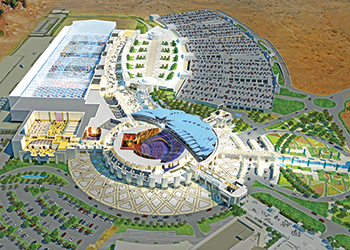 |
|
An artist’s impression. |
Transport
The sultanate’s transport sector has been offering ample opportunities for the construction sector through the expansion of airports, ports, roads and the proposed railway that will connect with the GCC-wide network.
As there are currently no rail lines operating in Oman, the country’s transport sector is heavily reliant on its extensive road network, which has been in the midst of an expansion. Early last year, Oman awarded 25 large road projects worth RO376 million ($973 million) as part of its efforts to develop the country’s infrastructure to global standards. These included the construction of asphalt roads which will extend across 280 km, and more than 40 km of mountain roads.
Key projects under way include the RO1-billion ($2.59 billion) Al Batinah Expressway, which is being implemented in nine packages and the 715-km Adam-Thumrait Road dualisation project, which has been divided into at least six segments. The first two parts of the Adam-Thumrait Road, which have a combined length of 240 km, are being undertaken by the UAE-based Ghantoot Transport and General Contracting and Consolidated Contractors Company. The remaining 475 km, which has been divided into four packages, will be tendered at a later stage.
The most ambitious project in the transport sector, however, is the national rail network, contracts for which are now eagerly awaited. A design-and-build contract is imminent on the multi-billion-dollar Segment One package of the network which covers the 207-km stretch from Sohar Port to Buraimi on the sultanate’s border with the UAE. Five consortiums had been shortlisted by Oman Rail.
Meanwhile, major rail contractors from Spain, Italy, China, Turkey, South Korea, Germany and France are vying for construction contracts linked to segments Two, Three and Four of the project, which covers a distance of more than 1,200 km stretching from Hafeet on the sultanate’s border with the UAE in the north, all the way down to Salalah in the far south of the country. Together with Segment One, they represent the strategic backbone of the country’s rail network linking Oman’s three maritime gateways at Sohar, Duqm and Salalah with the GCC rail system.
Airports & Ports
The airport sector has experienced significant activity chiefly aimed at supporting the tourism industry. The latest contract to be awarded in this sector is a $93.1-million deal for the construction of Sohar airport, which went to Indian engineering and construction firm Larsen & Toubro’s (L&T) regional subsidiary, which is already developing two other such facilities in the country.
The company built the new Salalah International Airport alongside joint venture partner Galfar Engineering & Contracting under a $764-million contract. The airport, which opened in mid-2015, has a capacity to handle two million passengers, although this could eventually be upgraded to six million.
Work on expanding Muscat International Airport – the largest airport in Oman – was 88 per cent complete as of last month. It involves the construction a new terminal with a capacity of 12 million passengers annually. Reports now put the launch of the new airport in early 2017.
In the ports sector, the sultanate intends to further expand Sohar port, located near the Straits of Hormuz, under a $12-billion investment project. Last year, the port underwent a $130-million (RO50 million) transformation that saw its capacity rise to 1.5 million 20-foot equivalent units (TEUs), from 800,000 TEUs. The next phase of the terminal’s development will add a further capacity of 2.5 million TEUs. Construction work is expected to begin next year for completion in 2018.
The government has also awarded the last construction packages for completing work on the Port of Duqm. These includes a contract for the customs department, police buildings and main gates while bids for the utilities for electricity, water and platform buildings are in the final stage of evaluation.
Meanwhile, Duqm Terminal, a unit of Oman Oil Company, has invited expressions of interests from engineering firms for the construction of topside infrastructure for a liquid storage terminal and dry bulk project at Duqm port. The project will serve as the outgo port for Duqm Refinery, an ambitious 230,000-barrel-per-day capacity greenfield project currently under development. While Phase One will be financed by the Special Economic Zone Authority at Duqm (Sezad), as part of its mandate to provide the basic infrastructure for the maritime and industrial hub, Phase Two will be funded by Duqm Terminal. The deadline for submission of letters of interest was January 22 (see Regional News).
Power & Water
Given the strong demand and shortage of supply, Oman is investing heavily to expand its water and electricity generation capacity as well as the supply networks. As such, Oman Power and Water Procurement Company (OPWP) has been pursuing a number of independent power projects (IPPs) and independent water and power projects (IWPPs) in the sultanate.
Last month, OPWP awarded a $2.3-billion contract to a consortium led by Mitsui & Company to build a total 3.15-GW gas-fired combined cycle power generation units for Ibri and Sohar-3 power generation projects in the northern region. The consortium also includes Saudi Arabian power company Acwa Power (Acwa) and Dhofar International Development and Investment Holding Company of Oman (see Regional News).
OPWP has also appointed three leading international financial, technical and legal consultancy firms for its ambitious water projects in the sultanate. Global professional services firm Pricewaterhouse Coopers has been roped in to provide financial advisory services, while Spanish engineering consultancy giant Ayesa has been tapped to provide technical advisory services and international law firm Curtis, Mallet-Prevost, Colt & Mosle has been retained to provide legal advisory services for these projects.
The three projects, which will together add 240,000 cu m per day of new capacity to the country’s potable water production infrastructure, represent the single largest procurement of water desalination capacity in the sultanate’s history. The largest of the three schemes – a 100,000-cu-m-per-day plant – will be coming up at Salalah, adjoining the existing IWPP of Sembcorp near Taqah.
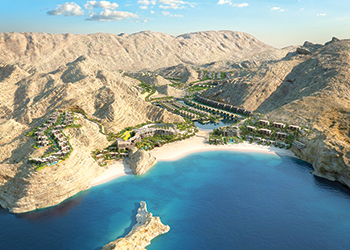 |
|
Saraya Bandar Jissah ... a $600-million integrated tourism complex under construction. |
Residential & commercial
Among the most prestigious projects under way in the sultanate is the Oman Conference and Exhibition Centre (OCEC) in Muscat, being developed by Omran, which will house meeting, conference and exhibition facilities. A landmark project being built at an estimated cost of $1.5 billion, OCEC is aimed at establishing the country as a major regional venue for regional and international events. The project will see its exhibition halls reach completion this year (see separate report).
Omran is also planning a RO500-million ($1.3 billion) waterfront development around Port Sultan Qaboos in the capital Muscat that will be open for private sector investment. It is also developing the Al Irfan Urban Development project, which will create a new downtown area for the Muscat capital district. The mixed-use project will be located on a 7.4-million-sq-m site, with strategic links to the nearby Muscat International Airport and the OCEC.
Another massive development is the $2.5-billion Omagine project by Omani developer Omagine – whose majority shareholder is the US-based Omagine – which is reported to be seeking funding for the first phase of the mixed-use tourism and real estate project in Muscat. The scope of work in the first phase includes the masterplanning, design, engineering and construction work besides the administrative, financial and marketing activities.
The company expects work on Phase One to start over the next 10 to 12 months. The development is proposed to feature a mix of hotels, retail shops, restaurants, office space, open-air amphitheatre and stage, exhibition venues, harbour and marina, and more than 2,000 residential units. The centrepiece is a high-culture theme park consisting of seven pearl-shaped buildings each with a different theme.
Meanwhile, the $600-million Saraya Bandar Jissah integrated tourism complex has made significant headway. Among the most recent projects to go ahead on site are two residential zones, Nameer and Wajd, which form part of the first phase of the complex and are scheduled to be completed by 2017.
In April, Habtoor Leighton Group (HLG) secured a $95.3-million contract to build the 112-room five-star Saraya Bandar Jissah Hotel, which is also scheduled for completion in 2017.
Other key projects include:
Duqm Beach Resort: This mixed-use project is being developed by Xsite Group and Al Jazeera International on a 450,000-sq-m plot in Duqm. Targeted for completion in 2020, the $500-million scheme will comprise a five-star and a four-star beach resort, residential units, an entertainment and recreation centre, an international school as well as commercial space for a shopping centre and offices.
The Links: Omani developer Badr Group has launched work on the Links, an integrated tourism complex in Muscat, with the award of the construction contract to Unique Contracting Company. Located in the ‘New Downtown’ area of Madinat Al Irfan, The Links is being developed as part of the master-planned Muscat Hills development, offering the opportunity for all nationalities to own freehold property in the precinct.
Liwa City: In a bid to address Oman’s housing shortage, the housing ministry intends to award a contract for Phase Two of a new RO500-million ($1.3 billion) city in northern Liwa. The second phase includes the construction of the infrastructure involving water and power supply, roads, communications and other services. The development, to be constructed over an area of around 8 sq km, will include 2,500 to 3,000 houses as well as eight schools, 11 mosques, health and social centres, shopping centres and landscaping. It will house nearly 30,000 people.
The Anantara Jabal Al Akhdar Resort: Located 2,000 m above sea level on the cliff of a grand canyon, the resort is being built by Alec. Featuring 82 rooms and 32 luxury villas, it will open this year (see Regional News).
Industries
Given the low oil prices, which have plummeted over the past year, the sultanate has been aggressively pursuing its plans for economic diversification through attracting investment in its industrial estates and economic zones.
The Public Establishment for Industrial Estates (PEIE) is currently implementing several projects geared towards providing the infrastructure at its new expansion schemes and attracting further investments. These include the development of the seventh stage for the Sohar Industrial Zone, as well as completing the services for the third to sixth stages.
Meanwhile, the Sezad has unveiled a 20-year plan to develop 150 sq km of land on the Wusta coast for industries and commercial investment. Phase One will focus on the development of medium and heavy industries, chiefly a grassroots refinery and petrochemicals complex over a 10-year period; while Phase Two – covering the 2026-2035 timeframe – will promote chemical and petrochemicals-related investments operating downstream of the anchor refinery and petrochemicals complex.
Among the largest industrial ventures under way is the $6.4-billion plastic manufacturing complex in Sohar. State-owned Orpic has awarded 15 agreements, including four major engineering, procurement and construction (EPC) contracts, for the Liwa Plastics Industries Complex. These deals call for the construction of a polymers plant in Sohar industrial area, a natural gas liquids (NGL) extraction plant in Fahud, a steam cracker plant and a 300-km-long pipeline from Fahud to Sohar. The project is expected to be commissioned in 2019.
Another pioneering venture in Sohar is the sultanate’s first sugar refinery, work on which has just commenced. The refinery is part of the new agro-industrial cluster taking shape at Sohar Port and Freezone, which features the development of an agro-terminal complex comprising, among other components, a network of grain silos and a flour mill.





















_0001.jpg)


.jpg)
















.jpg)








.jpg)



